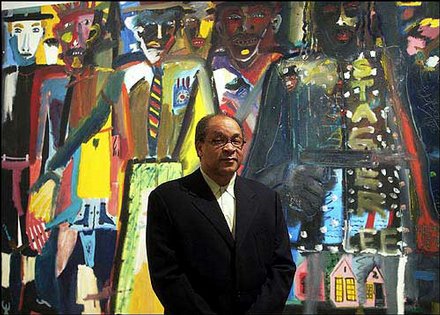 |
| Frederick J. Brown stands in front of his work Stagger Lee in this 2002 photo. AP photo via LJWorld.com |
Frederick J. Brown, Painter of Musicians, Dies at 67
Text | Bruce Weber for the New York Times
Frederick J. Brown, an American artist who explored the relationship between music and painting in portraits of hundreds of jazz and blues artists, died on May 5 at his home in Scottsdale, Ariz. He was 67.
The cause was cancer, said his wife, Megan.
Mr. Brown had a long and prolific career producing work on religious, historical and urban themes in addition to his portraiture. His work is represented in the collections of the Metropolitan Museum of Art in New York and the Kemper Museum of Contemporary Art in Kansas City, Mo.
Influenced by the German Expressionists and Abstract Expressionists like Willem de Kooning, who was his mentor for a time (and who was the subject of one of his most lauded portraits), Mr. Brown occasionally painted in the abstract mode, but he was largely a figurative painter unafraid of grand projects — large-scale canvases, murals, extended series. He was known for placing his subjects, often African-Americans rendered in muted tones, against backgrounds of intense color.
“He was a painter fascinated by abstraction but who dealt with figuration,” said Barbara O’Brien, chief curator at the Kemper, where Mr. Brown’s mammoth work “The History of Art,” a series of 110 interlocking paintings depicting the evolution of art across a world spectrum, is on permanent display. “I would call his style expressive realism.”
A friend of musicians from his boyhood in Chicago and later in the 1970s in New York City, where his SoHo loft became a gathering place for artists and writers as well, Mr. Brown sought to represent musical themes throughout his career.
Early works included a semi-abstract portrait of the saxophonist and composer Anthony Braxton, a friend from high school, and an Abstract Expressionistic splatter experiment titled “In Search of Jimi’s Space,” inspired by the guitar work of Jimi Hendrix.
In the late 1980s Mr. Brown began concentrating on portraits of musicians, creating a series that his family said eventually numbered over more than 300 paintings. His subjects included signature figures of 20th-century American music, among them Thelonious Monk, B. B. King, Count Basie, Louis Armstrong, Billie Holiday, Bessie Smith, Ray Charles, Ornette Coleman, Lionel Hampton and Jelly Roll Morton.
The paintings have been exhibited in shows at the Kemper, the Studio Museum in Harlem, the New Orleans Museum of Art, the National Portrait Gallery at the Smithsonian Institution and elsewhere. He once described his intention in painting as “trying to be as lyrical as possible, as smooth as Smokey Robinson.”
Frederick James Brown was born on Feb. 6, 1945, in Greensboro, Ga., and grew up on Chicago’s South Side. His father is said by some sources to have run a shoeshine establishment, though his wife said she was not sure that that was so. His mother worked in a pastry shop, where she was known for cake decorating. Musicians like the bluesmen Howlin’ Wolf and Muddy Waters were family friends.
Initially interested in architecture, Mr. Brown graduated from Southern Illinois University, where he turned to painting and art history. He traveled in Europe before moving to New York City in 1970. For a time in the 1980s he lived in China, where he taught in Beijing at the Central College of Fine Arts and Crafts, a sojourn that ended with a retrospective of his work at the Museum of the Chinese Revolution (now the National Museum of China) in Tiananmen Square.
In addition to his wife, the former Megan Bowman, whom he married in 1979, Mr. Brown is survived by a brother, Anthony; a sister, Edwina; a son, Bentley; and a daughter, Sebastienne.
Mr. Brown, who called music “the catalyst for much of what I do” and who often worked on a portrait while listening to the subject’s music, described himself as a kind of sensualist.
Painters are “people who love paint,” he said in an interview on the Web site of the Smithsonian American Art Museum. “Love to have it on them, love the feeling of it, love to touch it afterward.”
He added: “I grew up in a family in Chicago of people who dealt with color. My uncle was a body and fender person, who basically repainted Rolls-Royces and Cadillacs and limousines and things, and I basically grew up mixing paint for him. My mother was a baker, she specialized in Viennese pastries, and she’d get spun sugar rolled into really heavy buttercream cake decorations, things of that nature.
“So I grew up with the tactility and love of paint and color. In my mother’s case I was actually able to eat it.”
In 2012 my best friend left the physical world. He now paints the sky.
ReplyDelete